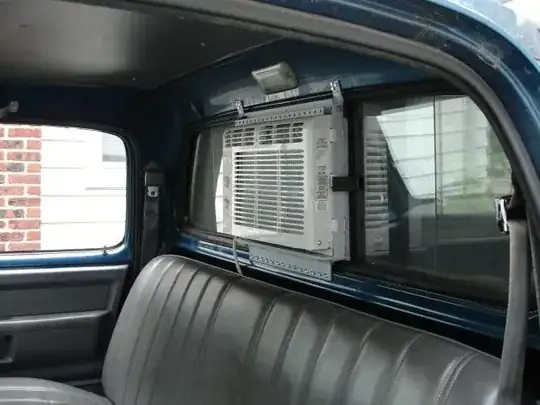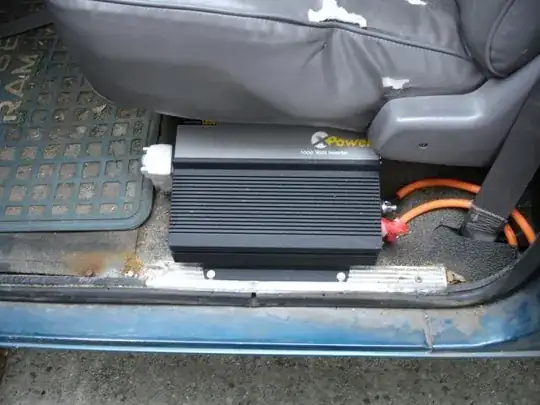Even if my home has no integrated air conditioner, I can add one in my room by buying a mobile air conditioner. But if my car does not have any air conditioner, can I create cool air with an equivalent device, like in a cigarette lighter?
12 Answers
Can't believe no one has posted this yet, but:
Source: https://geekologie.com/2019/07/meanwhile-in-florida-a-car-with-a-window.php
- 1,237
- 1
- 9
- 16
Practically no. An air conditioner is a heat pump: it takes heat from one location and pumps it to another location where it can be radiated. This takes a fair amount of power: a 12 volt auxiliary source isn't going to be enough to make a real difference. Also, the heat has to be pumped somewhere; you'd need a radiator somewhere outside of the cabin, or a heat exhaust pipe of some kind.
If you did have a portable device, the only way you could make it work without cutting a hole in your car somewhere would be to open a window in your car to let the heat out, which defeats the purpose.
- 216
- 1
- 10
- 18,048
- 3
- 38
- 67
Back in the 1940's and 1950's there used to be a product called a "Swamp Cooler". This was effectively an evaporative cooler that you sandwiched into your partially open car window. As you drove, air flowed through the device, was cooled by evaporation and ducted into the cabin (across the top of the drivers head).
I have no idea how well these work but there is a market in vintage units plus a number of guides online showing how to manufacture a modern reproduction unit.
- 23,464
- 2
- 41
- 92
The air conditioner in a car draws several kW of power. A cigarette lighter socket is limited to ~150 W, which is far too little to noticeably reduce the temperature in the car.
Things you can do to reduce the temperature in the car:
- paint the roof white
And things you can do while the car is parked to reduce the temperature when you get in:
- park the car in the shade
- when you can't park in the shade, place an insulation blanket on the sun-facing windows
- 4,422
- 18
- 23
I have used home made ac units that consists of a cooler, fan & ice (see video). It works GREAT for a hour or so depending on how hot the day is. You could get a 12V DC fan that plugs into your cig lighter and set cooler in passenger floor or seat. I used to freeze a few 1.5 gallon (5.7 litre) square jugs to rotate in and out so I always had ice available and no water to dump out.
- 107
- 5
- 3,820
- 1
- 15
- 27
It is certainly possible to retrofit air conditioning to cars, as long as they have the electrical capability to support it (or you upgrade the alternator too). Lots of classic cars are now using this method. You can buy kits or see an example for instance of all the individual components: from various suppliers
- 61
- 1
For a ratty old pickup truck that lost all of its R-12 from a leaky condenser, the cheapest fix was a supermarket-grade window air conditioner, an inverter that I already owned and some welding cable for the battery hookup. The factory original 140 amp alternator provided plenty of power.
The 4000 BTU/hour (4.2 MJ/hour) A/C provided plenty of cold air.
- 10,754
- 1
- 12
- 38
Some of these might work:
(Essentially google rv or truck dc air conditioning)
https://www.google.com/search?q=rv+dc+air+conditioner&ie=&oe=&safe=active
but anything that runs out of a cigarette lighter and/or doesn't vent to the outside is almost certainly a rip-off--It's either evaporative (if it doesn't vent) or won't do much cooling (if it's 12v).
AC takes a lot of electricity and cannot "Cool" air, it can only move heat from one place to another (From inside your car to outside, for instance)
edit/irrelevant note:
Now that I think of it though--if one really wanted to create an air-conditioner for a car with a design that made use of the high flow of wind outside the car as part of it's energy (Perhaps use a really low-power heat exchanger and use the car's movement to power all the airflow) one could probably do it pretty well. It's probably just never been worth it because running a built-in AC is so much more efficient/cheap.
Also, In the mid last-century (am I really that old?!?) after-market AC units that were wired into the engine like stock ones were somewhat popular for a while--you don't really see them any more, again probably a lack of demand.
- 213
- 2
- 8
The long road: A factory retrofit
First you skill up some electronics chops. This will be Very, very heavily electronics oriented.
Then, you get the schematics for your car, and you evaluate how the A/C normally wires into this car, particularly into the Powertrain Control Module and Body Control Module. Your objective is to determine whether your PCM and BCM can support air conditioning, and if not, whether it's practicable to change to a PCM and BCM that does. You may have to get into some programming to query or set the two computers to support A/C. If the A/C system gets into CANbus, then you've really got a job of it.
Then, you need to explore the car's wiring harnesses to make sure the necessary A/C wires are part of that harness. If not, you'll need to either retrofit them or make sure an A/C harness can be swapped in. For instance your vent/fan control may have a site for an A/C button; the question is whether the wires that go to that button are in the harness!
Then you'll need to change the vent control panel to support A/C. On newer cars this may involve fooling around with the Body Control Module (BCM).
You'll also need to make sure the wiring is there to support the A/C clutch, pressure sensor, and additional fans and relays (if used). You already determined that the PCM will support those if they're present.
At this point, you use resistors, LEDs and switches to rig up a "test setup" - make the car think all the A/C equipment is present, and see if you can get the car's computer to command the A/C system to cycle. It is very much in your interest to do these tests before doing any more work; because if you can't get the computer to command the A/C system to cycle, it's not going to work when you install it for real and charge it with freon.
At this point your car knows the way to the you-pick-your-part yard by heart.
If needed, you pull wiring harnesses (carefully, and completely) from junk cars. Do not cut and splice wires; that is unreliable. I saw someone buying a harness where the picker cut 30 wires because it was easier than taking a fender-well all apart. Now there'll be 30 crimps (60 connection points) up inside a fender well. Within a year one of them will fail. Forget that.
Then you find a suitable donor car and pull all the stuff:
- The air conditioning evaporator (goes under the dash)
- Heater core if your car uses a different heater core for A/C cars
- Heater duct box if that is different on your car
- The accumulator
- The compressor and bracket
- Any other parts needed to make room for the A/C compressor
- The A/C condensor (sits in front of the radiator)
- The larger radiator used on A/C cars
- The fan assembly used on A/C cars, possibly with an extra fan
- All piping connecting all of the above
- All grommets and strain reliefs holding all piping
- The A/C clutch relay
The picking yard will, at some point, have punched a hole in the system to bleed it. That means one pipe will be damaged. You'll need to find another car where the damage is on a different part.
Now, you assemble the whole kaboodle, with great care, ship-shape and in Bristol fashion. When an opportunity for a shortcut presents itself, like skipping a difficult-to-install grommet, set that emotion aside and do the job properly. The factory didn't put that grommet there for fun; they did it because it broke if they didn't.
Now off to the mechanic to get the system seal-tested and charged with freon. If you did your electrical testing earlier, the mechanic will repair any flaws in your work, and the system should spring to life.
The shorter, but more custom-fit road: aftermarket or marine
They make aftermarket kits for retrofitting A/C onto classic cars. They also make kits for installing A/C onto boats. Here, you'll have some of the work done for you; fair chance you can use a factory evaporator made for your car.
If you can get an A/C system that runs on 12V electric, you'll need a gigantic aftermarket alternator, but you can do that.
Don't waste your time with residential grade anything
The "Residential A/C unit + inverter" isn't going to work. The extremes of vibration, dust, and temperature that automobiles are exposed to, will murder the unit in short order.
- 5,409
- 15
- 34
Back In The Day (tm) air conditioning was an expensive option on a car. But people wanted air conditioning for their cars without paying the car manufacturers price, so other companies produced add-on air conditioning units that fitted beneath the dashboard of cars (which, back in the day, didn't go all the way down to the floor of the car). I remember seeing these units for sale at department stores like Sears, which would also handle the installation. And they worked well. My father worked for Eaton Corporation, which produced these units, and they always put one of their own units into whatever company vehicles they had. Dad used to buy the used company cars (they didn't get used very hard, and they got new ones every two years) so I remember using these when I was a kid.
And it looks like they're still available - see here: https://www.oldairproducts.com/products/ac-systems-parts/custom-street-rod-universal/underdash-systems?showpage=1
Well, actually you can. The concept of air-conditioner is to circulate air inside a closed room or space by adding some cold air, depending on the temperature you set.
Theoretically, you can create a small circulation inside your car using a mobile electronic fan but first, you will need to remove the hot air trapped inside your car. As for the cold air part, some fans now come with a built in mist release. Pour in some cold water so that you have your own source of cold air inside the car. It may not work accurately like a normal air-conditioner, but at least you have your mobile air-conditioner.
- 109
And they do exist - only not in "mobile form" - but many cars have build in AC - using little amount of fuel and direct coupling to the running engine plus a refillable (in repair shops) liquid to provide cooling effect - nice side is the air is dried, so it even helps in humid conditions
- 95



